 Udon Noodles
Udon Noodles© Denzil Green
Udon Noodles are Japanese noodles made from all wheat flour, though some new speciality ones for the “health food” market are a mixture of rice and wheat flours.
They are cream-coloured, and about the same width (4 to 6 mm wide) and length as linguine noodles, but thicker. In fact, there are four standard different thicknesses, with each being known by a different name. From thickest to thinnest, these are: himokawa, kishimen, hiyamugi and somen. The two thinnest ones, hiyamugi and somen, are mostly likely to be served in the summer.
They are made from flour, salt and water. The dough is kneaded, allowed to “ripen” overnight, then rolled out, and cut into strips.
The noodles can be sold fresh, par-boiled, boiled (instant) and dried.
They are served in a soup, or in the summer, boiled, then drained and cooled and served on their own with a dipping sauce.
Different udon dishes with broth will have different names, based on the topping:
-
- Kitsune Udon: topped with fried tofu. “Kitsune” means fox, as foxes are said to like fried tofu;
- Tempura Udon: topped with tempura shrimp;
- Curry Udon: topped with curry sauce;
- Nabeyaki Udon: tempura shrimp, wheat gluten cakes, fish paste dumplings, green vegetables, egg and bamboo shoot.
The best Udon is considered to be from Sanuki or Osaka.
Cooking Tips
The cooking time will vary based on which kind you buy; follow packet directions. In the absence of other guidelines, cook dried for 9 to 11 minutes; cook fresh for 2 to 3 minutes.
|
Amount
|
||
| Calories |
190
|
|
| Fat |
1 g
|
|
| Carbohydrate |
40 g
|
|
| Fibre |
1 g
|
|
| Protein |
5 g
|
|
Storage Hints
Dried noodles can be stored 6 to 8 months; fresh ones should be refrigerated and used within a few days.
Sources
Ashkenazi, Michael and Jeanne Jacob. The essence of Japanese cuisine: an essay on food and culture. University of Pennsylvania Press, 2000. Page 235.

